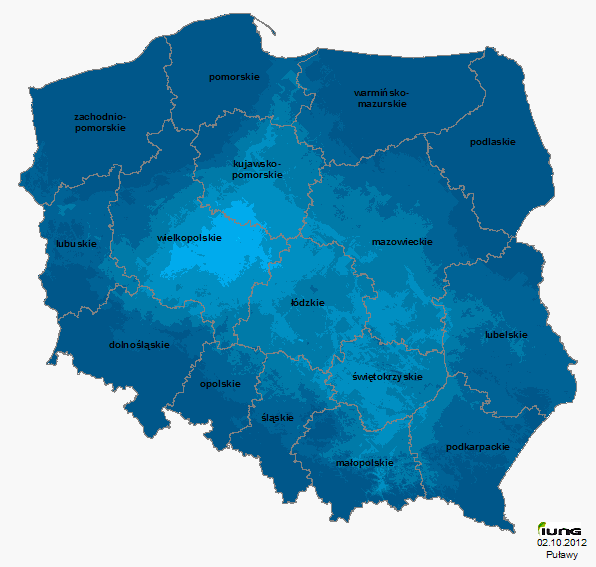ARCHIVES (2012)
Do roku 2016 raport oznaczony numerem 1 był tworzony za okres od 1 kwietnia do 31 maja. Od roku 2017 analizy są wykonywane o dekadę wcześniej czyli 1 raport oznacza okres od 21 marca do 20 maja
Communication report regarding the incidences of drought conditions in Poland
Year: 2012; period: 13 (1.VIII - 30.IX)
The Institute of Soil Science and Plant Cultivation - State Research Institute Puławy, in accordance with the requirements of the Polish law, has developed the climatic water balance for the whole of Poland (3,064 local districts). Based on the soil categories identified in those local districts; the current state of agricultural drought risk has been accessed for the following crops: rape and turnip rape, and sugar beet.
In the thirteenth reporting period from 1 August to 30 September 2012, we have not stated an agricultural drought occurrence in Poland. The value of climatic water balance (CWB), on the basis of which the drought risk assessment is calculated was negative but significantly higher than the critical values.
In the period between 1 VIII - 30 IX 2012, CWB values relative to the previous ten-day period, have increased across the country by an average of 22 mm, it means that the observed water deficit is smaller than in previous sixty-day period.
The lowest CWB values from -80 to -89 mm were recorded in the Południowowielkopolska lowlands. However, positive CWB values were not recorded in Poland.
In August, the highest precipitation was recorded in southern-western and northern-eastern parts of Poland (from 80-140 mm). The lowest precipitation was recorded in central Poland, in a belt from the north towards the south from 30 to 50 mm.
In September, there was a very wide variation in the occurrence of precipitation. High rainfall, from 60 to 120 mm, occurred in south-west and in Pobrzeże Koszalińskie. In other parts of the country, precipitation was lower (35-60 mm). The lowest precipitation was from 20 to 35 mm and was recorded on the Szczecin Coastland, Wielkopolska Lake District, and the Połnocnopodlaska Lowland and in the Lublin region.
Within the whole sixty day period the lowest values of rainfall were recorded in Pojezierza Chełmińsko-Dobrzyńskiego, Środkowomazowieckiej Lowlands, Wzniesieniach Południowomazowieckich, Południowowielkopolskiej Lowlands, Śląsko-Krakowskiej and the Małopolskiej Highlands (from 60 to 100 mm). The highest precipitation was recorded in the south-western part of Poland and the Koszalin Coastland (140-190 mm).
In July, there were very large variations in air temperatures and sunshine duration in Poland. Throughout August, the warmest area was in the Śląska Lowlands and Uplands, Malopolska Uplands and the Sandomierz Basin (from 19 to 19.5°C). However, in September it was the warmest in the Lowland and Upland Silesian and in the Sandomierz Basin (from 14.5 to 15.5°C).
In August the coldest region was in the northern and north-eastern regions from 15 to 17oC, while in September in the north-eastern and south-western areas of the country, from 13 to 14oC.
The highest sunshine duration in August was recorded in the south-western part of Poland, it was 240-290 hours, the least sunny region in the country this month was in the area north (175-210 hrs.). However, in September, the most hours of sun was in the west and in the eastern parts of the Lublin region (180-200 hrs.), and the least in the southern parts of Poland (140-160 hrs.).
Throughout the sixty-day period, the highest evapotranspiration took place in south-western parts of Poland (160-170 mm) and lowest in the north of the country (130-150 mm).
Other relevant periods should be considered as favourable for crops in terms of moisture, because there were no areas with water excess, and a small deficit does not cause adverse effects in the course of the growing season.
Since the beginning of July a small water deficit did not cause very negative effects in the course of the growing season and large losses in crop yields. However, rainfall that occured in the Malopolska Uplands and the Lublin region in the third week of September in the amount of 15 to 33 mm, significantly improved water for these areas, and they were especially favourable for winter crops, oilseed rape and sugar beet. In this area (in the Lublin region from 20 July, and the Malopolska Uplands from 1 August), reported a relatively large water deficit, where in recent weeks it was significantly reduced.
Reports
- Report 13 (1.VIII - 30.IX)
- Report 12 (21.VII - 20.IX)
- Report 11 (11.VII - 10.IX)
- Report 10 (1.VII - 31.VIII)
- Report 09 (21.VI - 20.VIII) +
- Report 08 (11.VI - 10.VIII)
- Report 07 (1.VI - 31.VII)
- Report 06 (21.V - 20.VII)
- Report 05 (11.V - 10.VII)
- Report 04 (1.V - 30.VI)
- Report 03 (21.IV - 20.VI)
- Report 02 (11.IV - 10.VI) +
- Report 01 (1.IV - 31.V) +





